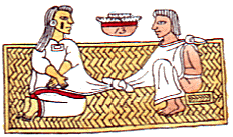| |

An Aztec man and woman are united in marriage by having their cloaks tied together in a solemn ceremony.Image from the Lord Kingsborough Antiquities of Mexico, photographed from the hand-colored originals, housed in the Dolores and John Mitchell Special Collections Room, the J.E. and L.E. Mabee Library, University of the Incarnate Word, San Antonio, Texas.
|
|

 Physical Physical
 Religious Religious
 Artistic Artistic
 Economic Economic
 Social Social

|
|
| |
THE SOCIAL ENVIRONMENT
 s Mesoamerican cultures grew in complexity, several social classes emerged. The families of village chiefs evolved into powerful ruling classes. The nobility could own land, occupy important posts, and receive tributes. Beneath the ruling classes, but also in positions of authority, were the priests, whose primary source of power came from their ability to predict rain cycles. Both men and women served as priests in the temples. Merchants were a distinctive class of their own and were considered ambassadors who linked the vast Mesoamerican world through trade. The common people were lower-ranked warriors, artisans, and farmers.
s Mesoamerican cultures grew in complexity, several social classes emerged. The families of village chiefs evolved into powerful ruling classes. The nobility could own land, occupy important posts, and receive tributes. Beneath the ruling classes, but also in positions of authority, were the priests, whose primary source of power came from their ability to predict rain cycles. Both men and women served as priests in the temples. Merchants were a distinctive class of their own and were considered ambassadors who linked the vast Mesoamerican world through trade. The common people were lower-ranked warriors, artisans, and farmers.
|
